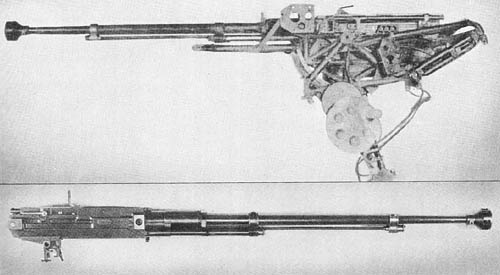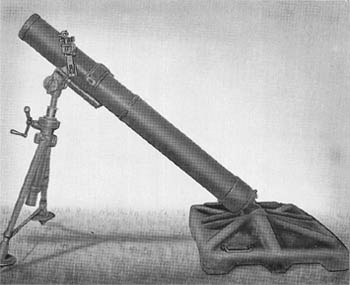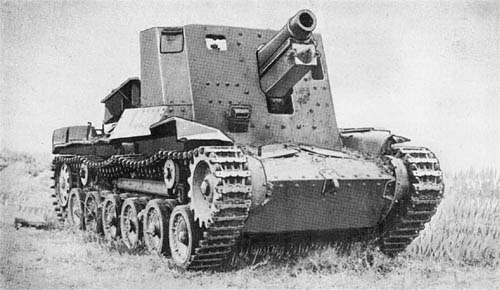
This Japanese 20 mm aircraft gun is a modified version of the Model 97 antitank gun described on page 101. It is a gas-operated, full-automatic, magazine-fed, air-cooled weapon. The barrel, of monobloc construction, is fitted with a muzzle brake and attached to the receiver by means of a bushing of the interrupted screw type. The magazine fits into a rectangular opening in the top of the receiver, and the empty cartridge cases are ejected from a similar opening in the bottom. The ejector is secured to the underside of the receiver top just behind the magazine opening.
The operation of the aircraft version of this gun is similar to that of the antitank rifle. The six phases are: loading, locking, firing, unlocking, extraction, and ejection.
The first three occur on the counterrecoil, and the last three on the recoil. The gun is cocked the first time by pulling the retracting handle to the rear. This retracts the operating group to the position where the sear will engage the gas piston and hold it to the rear. After the magazine is inserted and locked in place, the gun is ready to fire.
The gun was mounted in the dorsal turret of the Bomber “Helen” on a semicircular-shaped rack, and is fixed to the rack by the lower left hand edge of the receiver. The rack is used for elevating the gun. The gun and mount are in turn mounted on the turret ring. The sight used on this gun is a reflector type sight and it is believed that there is provision made for deflection shooting. A fixed version has also been reported. Documentary evidence discloses that the ammunition for the turret gun is referred to as HO1 and the fixed as HO3.
SPECIFICATIONS
| Caliber | 20 mm (.79 in.) | |
| Weight (without mount) | 74 lbs. | |
| Length (with muzzle brake) | 68 7/8 ins. | |
| (without muzzle brake) | 67 1/4 ins. | |
| Sight radius | ||
| Principle of operation | Gas | |
| Capacity of feeding device | Magazine, 15 rds. Inverted saddle type, 50 rds. | |
| Cooling system | Air | |
| Ammunition types | AP/T; HE/T; HE/I; Ball | |
| Rate of fire (estimated) | 300 rds. per min. | |
| Type of sight | Reflector | |
| Weight of barrel | ||
| Length of barrel | 47 ins. | |
| Length of rifling (approx.) | 42 ins. | |
| Rifling | ||
| Twist | ||
| Form | ||
| No. of lands & grooves | 8 | |
| Depth of grooves | ||
| Width of grooves | ||
| Chamber pressure | ||
| Muzzle velocity (estimated) | 2,500-2,900 ft. per sec. | |
| Muzzle energy | ||
| Effective range | 1,000 yds. | |
| Type of mount | Dorsal turret and fixed |
Japanese: p. 253 (August 1, 1945)

